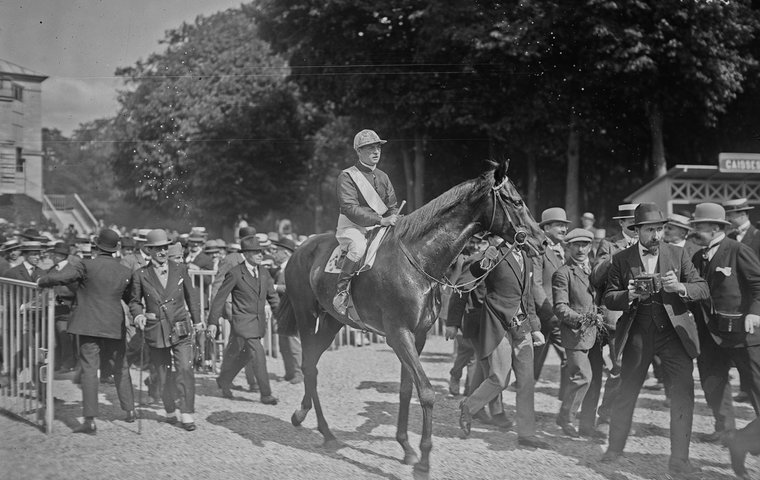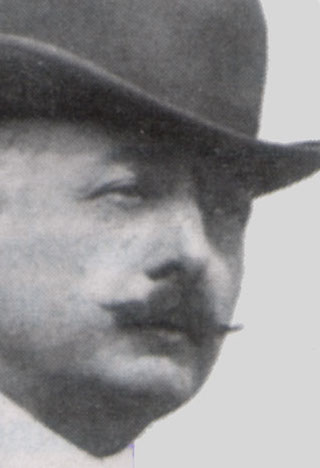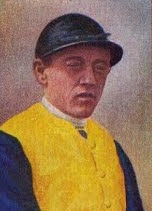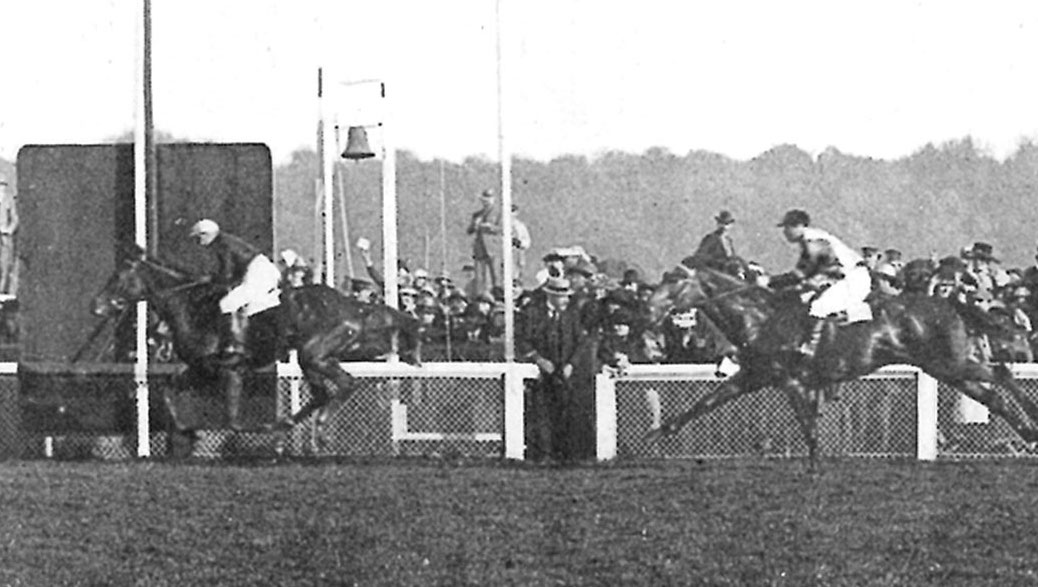
The Prix du Jockey Club (French Derby) is one of three great Classics over the weekend, alongside the Epsom Derby and the Belmont Stakes. To mark the latest running, John Gilmore looks back more than 100 years at a fascinating period in the race’s history, when it was dominated by American jockeys - and one notable European.
In 1922, George Stern, France’s most famous jockey in the early part of the 20th century, won his sixth Prix du Jockey Club aboard Ramus and the first for the great owner-breeder Marcel Boussac. Stern was not only the rider. He had been training Boussac’s horses since 1919.
Nicknamed ‘King of the Derbys’, his record number of wins in the race has only been beaten once since - by Yves Saint-Martin, who recorded his 7th victory on Darshaan in 1984, and eventually totalled nine, the last being Natroun in 1987.
Stern, like most people in Chantilly at the time, came from a racing family. His English-born father, also George, became a small-time Chantilly-based trainer in the later part of the 19th and early 20th Century. And his mother, Marguerite Watkins, born in France from English parents, was the daughter of a successful jockey, James Watkins.
This background enabled young Stern to learn the valuable skills needed to be a jockey.
Born on September 29, 1883, Stern won his very first race, in a tight three-way finish over 2,600 metres, riding Finlas, trained by his father, at Colombes in April 1898, when he was just 14. Just two years later, he was champion jockey in France for the first time with 91 winners.
Partnership with Edmond Blanc
 His exploits drew the attention of the celebrated owner-breeder and businessman Edmond Blanc (pictured left), who signed him up as a retained jockey.
His exploits drew the attention of the celebrated owner-breeder and businessman Edmond Blanc (pictured left), who signed him up as a retained jockey.
On June 2, 1901, at the age of just 17 years 8 months and 5 days, Stern won his first Prix du Jockey Club on the Edmond Blanc-owned Saxon, trained by Robert Denman. He remains the youngest jockey to win this race.
He ended the year champion jockey once again, with 110 winners, and went on to take the title every year from 1904 to 1908.
He won two more Prix du Jockey Club during this time for Blanc and Denman, with Ajax in 1904 and on Quintette in 1908 in a dead heat with Sea Sick, ridden by American Milton Henry, who had won the race the previous year with Mordant. Henry also took the Jockey Club in 1911 on Alcantara.
Indeed, Stern aside, American jockeys were dominant in the first decade of the century, winning half of the ten Jockey Clubs: John Reiff (Retz 1902), Charles Thorpe (Ex Voto 1903), Nash Turner (Finisseur 1905), plus Milton Henry's two winners.
But Stern remained the rider to beat. He won four Prix de Diane in that same decade (Profane 1904, Medeah 1908, Union 1909, and Marsa 1910). All were trained by Denman for owner Blanc.
The 1908 season was particularly good for Stern. Not only did he take the French Derby, he also won two others - in Germany and Austria - and was second in the Epsom Derby.
Stern’s success in the early 1900s was all the more remarkable as he faced strong competition from an influx of leading American jockeys, who were disillusioned by the increasing restrictions to off-course betting in certain North American states, in particular New York, with inevitable lower prize money and reduced racing. By the end of 1910 virtually all gambling had been outlawed in the States.
Stern was quick to realise the advantages of the American jockey crouch style as opposed to the European upright positioning and adapted his technique accordingly. He was well known for his natural ability, cool head, judgement of pace, balance and ability to make quick decisions.
U.S. jockeys soon made their mark in France. They were particularly adept at getting quick starts and judging the pace. Jay Ransch, John Reiff, Milton Henry and Winfield O’Connor arrived in France at the beginning of the 20th century and were immediately leading jockeys, with Reiff and Henry topping the table in 1902, ahead of Stern, and Ransch being champion the following year, with Stern second and O’Connor third.
It wasn’t all plain sailing, however. Reiff’s licence was withdrawn by the Société d’Encouragement in 1901 for complicity in dishonest practices, which he disputed. After winning a court case, his licence was given back the following year. Despite a year’s layoff, he still became champion jockey and also won the Prix du Jockey Club on Retz. He won the 1907 Epsom Derby on Orby for American politician Richard Croker and in 1912 on the filly Tagalie for owner Walter Raphael. He finished first the following year on Craganour in the notorious Suffragette Derby only to be controversially disqualified for interference.
More American jockeys came to France after gambling on racing was finally totally forbidden in the States with the 1908 Hart-Agnew anti-betting legislation. They included Guy Garner, Matt Mcgee and Frank O’Neill, accompanied by his American trainer Frederick Burlew.
Along with the jockeys, American owners and breeders Vanderbilt, Cohn, Ogden, Wilner and some others also set up shop in France. William B Vanderbilt, one of the richest men in the world at the time, became a major rival to Edmond Blanc, and won the Jockey Club four times - with Maintenon (1906), Sea Sick (1908), Negofol (1909) and Tchad (1919).
Rivalry with Frank O’Neill
 Negofol was ridden by O’Neill (pictured left), who was under contract to ride for Vanderbilt more or less as soon he arrived in France, and Tchad by another American, George Belhouse. All the winners were trained by American William B Duke, who was Vanderbilt’s private trainer. O’Neill later also rode for Baron Edouard de Rothschild.
Negofol was ridden by O’Neill (pictured left), who was under contract to ride for Vanderbilt more or less as soon he arrived in France, and Tchad by another American, George Belhouse. All the winners were trained by American William B Duke, who was Vanderbilt’s private trainer. O’Neill later also rode for Baron Edouard de Rothschild.
Competition for the locals became more intense after this new influx of American jockeys.
Sandwiched between Stern’s last championship in 1908 and O’Neill’s first in 1910 was Maurice Barat’s success in 1909. It was the first time a Frenchman had ever won the championship since racing started there in 1834. It had previously always been won by British jockeys or their descendants, and just twice at that point by Americans.
All that was set to change. Between 1910 and 1922, every championship was won by an American jockey, O’Neill winning the title ten times and Guy Garner twice (1917 and 1918). In 1915, no racing took place because of the First World War. The Prix du Jockey Club was cancelled until 1919.
Stern may not have won another title after 1908, but his popularity and reputation never waned - in France and in Britain, where he won both the 2000 Guineas and Derby in 1911 on Sunstar despite the horse sustaining an injury to a suspensory ligament in a training accident nine days before the Derby. Stern won the Guineas in a canter and claimed at the time Sunstar “was a certainty for the Derby” despite stamina doubts over the sprint-bred horse.
The injury was hushed up and trainer Charles Morston and owner J B Joel decided to let the horse take part. Sunstar was sent off the 13/8 favourite as Morston and Joel looked on from the stands hoping the leg would hold up. Sunstar and Stern cruised into the lead in the straight, but inside the last furlong the horse’s stride began to falter. Stern did well to stay in the saddle as Sunstar courageously just lasted home on three legs. The horse never ran again.
A famous rematch
Back in France, Stern followed up with two more Jockey Club wins - on Dagar in 1913 and Sardanapale the following year. Dagar, like Stern’s 1904 winner Ajax, was by 1899 British Triple Crown winner Flying Fox. Blanc bought Flying Fox following the liquidation of the Duke of Westminster’s stock for a substantial sum in 1900. The horse was later champion sire in France three times.
The year 1914 was the centre stage for a celebrated race between two brilliant jockeys and two top-class racehorses, La Farina (ridden by O’Neill and owned by Edouard de Rothschild) and Maurice de Rothschild’s Sardanapale (ridden by Stern). At the beginning of the year, La Farina beat Sardanapale in both the Prix Daru and the Prix Lupin. But Sardanapale easily won the Prix du Jockey Club by two lengths.
A re-match took place in the Grand Prix de Paris at Longchamp over 3,000 metres before a large, expectant crowd on June 28. The race was all about tactics as O’Neill set a strong pace to make it a true test of stamina with Stern biding his time some way off the pace. Entering the straight, La Farina was still some way in front and many spectators thought Stern had left his finish too late. Always the man for the big occasion however, Stern showed his trademark icy nerve and gradually began making up the ground. The pair drew clear of the rest of the field and Stern and Sardanapale got up to win by a neck after a titanic struggle. Both horses received tumultuous applause as they returned to the winner’s circle.
Sardanapale later was rated one of the best horses in the first half of the century. The day, however, ended badly, with news that Austria’s Archduke Ferdinand and his wife had been assassinated in Sarajevo. The Austrian Ambassador, who was at Longchamp, left straight away after it was announced. The assassination leds to the start of the First World War.
Racing was cancelled in 1915 and limited meetings took place during 1916-18. Stern, who had dual nationality, applied to join the British Army in 1915, but his request was turned down on account of his size (he was just 5ft tall). O’Neill and other Americans were free to continue riding as the U.S. didn’t enter the war until 1917.

Stern rode a lot in Spain during the war, where 250 French racehorses were transferred. It was there that he first came in contact with the American owner Jefferson-Davis Cohen, who later became a leading owner in France.
In 1914, Cohen bought Teddy (a son of Ajax) for 5,400 francs as a yearling, but due to the war the horse was shipped to neutral Spain to race in San Sebastian. During 1916, Stern rode Teddy to win five of his seven races, including the Spanish St Leger. Teddy later became a major stallion for Cohen in France during the 1920s.
After the war, Stern began to have weight problems and rode less often. But he started training successfully for Marcel Boussac from 1919. This reached a climax when he rode Ramus to victory for Boussac in the 1922 Prix du Jockey Club. The year before, Stern also won the second running of a new race that was to take on increasing significance - the Prix de l’Arc de Triomphe. Stern’s 1921 winner was Blanc’s Ksar, trained by Walter Walton.
Ksar had been bought by Blanc as a yearling for 151,000 francs from the Haras de Saint Pair at the August 1919 Deauville sales. Blanc, a lifetime influence on French racing and breeding - and the man who ‘discovered’ Stern, died in December 1920.
Stern was unable to ride Ksar when he won the 1921 Prix du Jockey Club - as he was contracted to ride the Marcel Boussac colt Grazing, who finished second. Nor was Stern aboard for Ksar’s second win in the Arc a year later as he was again contracted to ride for Boussac - on Ramus, who got left at the start. Australian Frank Bullock took the honours in both races.
Stern continued riding and training Boussac’s horses until 1925. His last major winner that year was both riding and training Banstar for Boussac in the Prix Morny, his tenth victory in the race and third for Boussac. He then became a public trainer but sadly just three years later, in October 1928, he died after a serious case of uremia.
Stern remains a legend of the French turf.
His great rival, Frank O’Neill, finally won the English Derby at the age of 34 on Spion Kop in 1920. The horse was trained at Newmarket by Peter Gilpin for owner Giles Loder. O’Neill followed up four years later with an Oaks win on Straitlace for owner Edward Hutton sand trainer Dawson Waugh.
In July 1920 Vanderbilt died. Abraham Macomber, an American adventurer and businessman, had taken over his racing operation and stud at Haras du Quesnay just a few months earlier for 12 million francs. Like Vanderbilt, he still retained O’Neill as his jockey, and in 1923 O’Neill won the Arc for him on Perth, trained by J H Crawford. O’Neill was the first American jockey to win the Arc. Cash Asmussen (Suave Dancer, 1991) is the only one to do so since.
O’Neill retired from riding in 1928 and after a brief spell training eventually ran a popular bar in Paris until the Second World War, when he moved to Spain. After the war, he returned to Paris, but he went back to America in 1955 and died in 1960. He entered the U.S. Hall of Fame in 1956.
William Duke, who had trained Vanderbilt’s horses for 12 years until his death in 1920, became the Aga Khan’s trainer. Duke trained his fifth Prix du Jockey Club winner when the Aga Khan’s Pot au Feu triumphed in 1924 under the American Guy Garner. The following year he returned to the States at the age of 68 and started training for Gifford Cochrane.
That same year, he trained the Kentucky Derby winner, Flying Ebony, for Cochrane. He died a year later after a short illness.
The winner of five French training titles and eight French Classics, he entered the American Hall of Fame in 1956, the same year as O’Neill.


